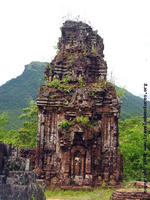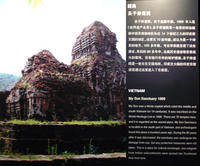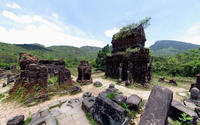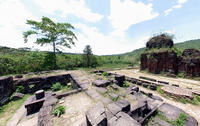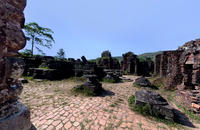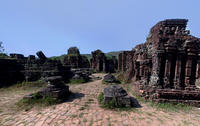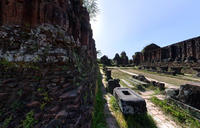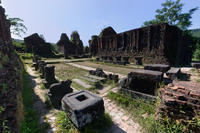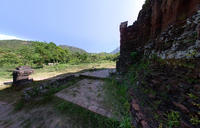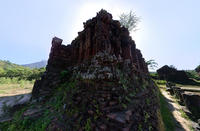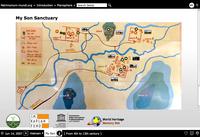You are in: Asia -> Vietnam -> My Son Sanctuary, and traditional search or Image Gallery will yield results of this site only
My Son Sanctuary
| Site number: | 949 |
|
| Type of site: | Cultural | |
| Date: | 4-13 Century | |
| Date of Inscription: | 1999 | |
| Location: | Asia, Viet Nam (Vietnam), Quang Nam Province, Duy Xuyen District, Duy Phu Commune | |
| Video: |
|
Up to 75 images are shown here. Click on each for more details or on Image Gallery for more images.
| Description: | A rare culture, owing owed its spiritual origins to Indian Hinduism, developed on the coast of contemporary Viet Nam between the 4th and 13th centuries. A visual illustration is available through the remnants of a series of imposing tower-temples that sit in a dramatic site –for most of its existence it was the Champa Kingdom’s religious and political capital. --WHMNet paraphrase from the description at WHC Site, where additional information is available. For 360 degree imaging of this site, click here. | |
| Mỹ Sơn (Mee Sern) is a Hindu temple complex, located in the village of Duy Phú, in the administrative district of Duy Xuyên in Quảng Nam province in Vietnam, 69km southwest of Da Nang, and approximately 10 km from the historic town of Trà Kiệu. It comprises many Champa temples, in a valley roughly two kilometres wide, surrounded by two mountain ranges. It was the site of religious ceremony of kings of the Champa dynasty, and was also a burial place of Champa royals and national heroes. The Mỹ Sơn temple complex is one of the foremost temple complexes of Hinduism in South East Asia and is the foremost heritage site of this nature in Vietnam. This temple complex is often popularly compared to other temple complexes in South east Asia, such as Angkor Wat (Cambodia), Borobodur, (Java, Indonesia), Pagan (Burma) and Ayutthaya (Thailand). As of 1999, My Son has been selected by UNESCO as a world heritage listed site, at its 23rd meeting, under the criteria C (II) as an example displaying the evolution and change in culture, and criteria C (III) as a foremost evidence of Asian civilisation which is now extinct. --Wikipedia. Text is available under the Creative Commons Attribution-ShareAlike License. For 360 degree imaging of this site, click here. | ||
| Source: | http://whc.unesco.org/en/list/949 | |
| Source2: | http://whc.unesco.org/en/list/949/video | |
| Reference: | 1. UNESCO World Heritage Center, Site Page. | |


 NHK World Heritage 100 series
NHK World Heritage 100 series

